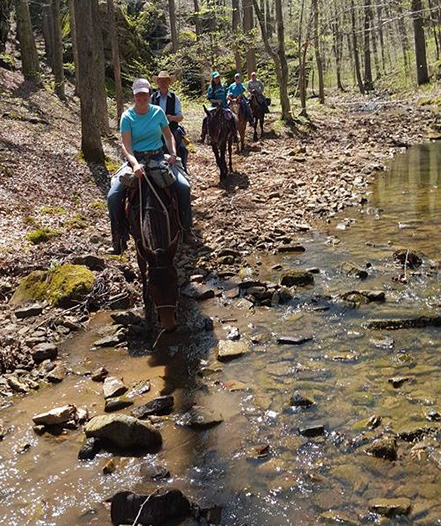
Trail riding is a family-friendly activity that is reasonably inexpensive, non-competitive and affords relaxation on nature’s scenic trails. Many individuals seek trail riding as a hobby in their retirement, connecting with old friends from the past and making new friends on each day’s ride. Many young people enjoy the responsibility of a horse or pony along with riding with their families.
Intermediate trail rides last for more than one day. The ride may be arranged and sponsored by a local group or may be one where a fee is charged to cover amenities like meals, scheduled rides, and campsites. Single day rides start from and return to a central camp site each day with the equipment remaining at a site. Other rides may be a week or more in length covering 15 to 40 miles a day in a continuous direction. In this case, some provision is made to bring riders’ equipment forward each day from the previous night’s camp to the new location.
In either case, riders are under supervision of a trail boss. Large rides may have an all-day “fast” ride and an all-day “slow” ride, along with a half-day “fast” and a half-day “slow” ride. Fast rides may include gaited horses or others who can maintain a faster pace. Slow rides may include stock or hunt type horses that walk more slowly.
Selecting the ride
A ride should be judged on scenic beauty, accommodations, and cost. Before committing for a week’s ride, it can be helpful to ask questions from someone who has attended a previous ride. Ask how many hours are usually ridden daily and what kind of housing is available or needed.
Clear, cold water running through meadows with tree-fringed banks nearly always appeals to trail riders. If the terrain allows, a stream may be crossed many times in a day’s ride. A ride may go upstream until noon where lunch is served on its banks, then riders return down the opposite side in the afternoon. During the process they may cross the stream some ten or twelve times. Streams can be combined with rough country to provide scenic beauty and add interest to the ride. The most interesting scenes should be used as lunch sites or rest stops.
Hill and mountain riding can be popular but must be carefully selected as it can be challenging for horse and rider. Hill riding in heavy timber may be hot because of little air circulation in warm climates. For this reason, riders may wish to ride in the hills during the cooler seasons of autumn or spring.
Some rides can be arranged through areas of wildlife preserves and areas where wild game can be seen. However, during hunting season, some trails may be closed or unsafe due to hunters. Riders should check with Missouri Department of Conservation to check trail availability before hauling. Further, if riding on Missouri Department of Conservation lands, a group permit may be required if the group is 10 riders or more. Visit Special Use Permits for more information.
Before booking a ride that charges a fee, look online at facilities, reviews, and provided accommodations. Most large rides will have websites or social media sites with more information. Advanced planning is important because most rides require pre-registration and have participant limits.
Consider camp accommodations
Most commercial camp sites have electric service in areas offering shade. Living quarter trailers, campers and even tents are used by most trail riders. A large camp may accommodate 1,500 riders and include amenities like electric hookups, a large cooking and dining tent or hall, cabins, bath or shower houses and an arena.
Additional recreational opportunities may accompany some rides. Some people enjoy swimming their horses at the end of a long ride after they have cooled them out. While this can be fun, it can also be dangerous if not handled properly. Riders should be able to swim competently if they plan to take horses through deep water. Some horses will rear when they get in deep water before they begin swimming while others may try to lay down and roll in the water. Riders can drown if they are dislodged and knocked unconscious by the horse, so riders of all ages should never swim horses by themselves.
Many rides are located adjacent to rivers that allow for float trips. A good change of pace for riders is to come in early and take advantage of this, especially during summer months. Where rivers have a reasonable amount of current, a float trip of several miles can be taken in a few hours. There are often operators who will rent canoes, kayaks, or rafts and pick up people downstream at predesignated locations.
Many young people and adults enjoy a dance at night after trail riding. Some rides furnish bands and a dance floor for entertainment. However, riders who like to go to sleep early may choose to camp farther away from nightly activities. Many trail rides have organized horse shows with a variety of fun classes. Remember, the main purpose of the trail ride is enjoyment. However, if winning is your main priority, consider leaving showing for another occasion. Some rides also have church services, tack stores, on-site farriers and feed and hay suppliers.
Type of horse for trail riding
Most any type, size, age and quality of horse can be seen on large trail rides. One reason trail riding is popular is because there is no competition and no rivalry between riders as they follow the trail boss over the trails. However, serious trail riders usually agree on broad generalities to describe a good trail horse.
A good trail horse is large enough to carry the rider well, is soft in the gaits for its breed, with more than average speed at the walk. Since much of the riding is done at a walk, a horse should be able and willing to stride long and fast at a rate of about four miles an hour. The horse should travel with a purpose and be willing to keep up with the other horses without getting too close to the horse in front of them. When most of the horses in a line are walking and one horse must jog or trot to keep up, that rider may want to consider a different mount or choose to participate in a slower ride. The horse should be safe to ride, willing to cross all obstacles, be sure-footed, and be responsive to guidance from the rider.
A suitable trail horse should be healthy and in good physical shape with adequate endurance to handle the different types of terrain on the trail. There is a lot of difference in the weight-carrying ability of horses. Some horses may need to be rested every other day while others can carry a rider every day. To avoid over fatigue, horses should not be asked to carry much more than 20 or 25 percent of their body weight.
Avoid bringing green horses or those that may buck, run away, or kick other horses. Trail riding should be fun for all participants and these types of horses can take away from the enjoyment and pose a safety risk.
Conditioning for horse and rider
Riders should condition themselves as well as their horse before trying long trails or those with difficult terrain. Although some riders condition their horses at slow speeds, horses need forced exercise to reach top physical shape. It may take a minimum of three weeks to get a horse ready for a trail ride. An overweight horse may need four or five weeks of reduced feed and increased riding to get in condition.

Proper conditioning may start with a half-hour ride a day, increasing to an hour or more daily, and working up to two-hour rides. By the end of the conditioning period, a daily ride of about half the distance of an average day on the trail is sufficient. Two horses can be conditioned at the same time by riding one and leading the other.
For a horse that is thin, increase the amount of feed or fat content and exercise to gain more conditioning before the ride. A horse will likely lose weight while on a ride. Thin horses may also be more likely to develop tack sores on long rides.
Do not take your horse on a long ride if their feet are in poor condition. Horses with overgrown hooves tend to have long toes, putting more pressure on the horse’s heels, tendons, and ligaments. This can predispose them to soft tissue injuries or tears which may take months to heal or cause career-ending lameness. Further, horses with overgrown feet are more likely to trip or stumble on the trail posing a safety risk to both horse and rider.
Horses should be shod two to three weeks ahead of the ride. This allows the sole time to thicken and the wall time to grow down enough to get the horse’s feet up off the rocks. If correction is needed, it gives the owner time to do so before leaving home. On rocky trails, horses may be better off with pads under their shoes to protect from stone bruises. It is not recommended to take horses without shoes for long trail rides as many rides cover rocky terrain.
What to bring for people and horses
If the heat or humidity is excessive, riding may only occur in the morning. As the heat of the day increases, the trail should lead to shaded areas. When riding through timber, long sleeves may be needed. Raincoats and warm layers should always be carried in case of weather changes on the trail. Branches are also a “headache” for riders wearing wide-brimmed hats. If the ride is in brushy country, wear a narrow-brimmed hat, a cap, or go without a hat. In hot weather or in areas of intense sunshine, hats usually are desirable. Riders should also bring insect repellent, sunscreen, and a first aid kit. For horses, at minimum, riders should bring fly spray, hoof pick, fencing pliers and hoof boots in case a horse loses a shoe. Below is a suggested checklist for horse, rider, and campsite that may be useful.
Packing list
Supplies for the horse
- Halter
- Lead rope
- Neck rope
- Support boots
- Hoof boots
- Saddle
- Bridle and reins
- Saddle pads or blankets
- Breast collar or crupper
- Saddle bags/Pommel bags
- Cinch
- Picket line or portable fencing
- Hay
- Grain
- Feed supplements
- Water (if not available on site)
- Manure rake
- Feed and water buckets
- Hay bag or net
- Feed scoop
- Fly repellent sprays
- Negative Coggins Test
- Health certificate
- First aid supplies
- Vet wrap
- Scissors
- Gauze
- Antiseptic like alcohol, peroxide, or iodine
- Wound ointment or spray
- Tape
- Needles
- Syringes
- Anti-inflammatory/pain reliever like flunixin meglumine or phenylbutazone
- Thermometer
- Disposable gloves
Supplies for the rider
- Head lamp
- Riding attire
- Rain gear
- Jacket or coat
- Pocket Knife
- Hat
- Helmet
- Sunscreen
- Insect repellent
Supplies for the trail
- Hoof pick
- Pocket knife
- Fencing pliers
- Lunch or snacks
- Water bottle
- Halter and lead rope
- Helmet
- Saddle bags/pommel bags
- Insect repellent
- Sunscreen
- Rain gear
- Map of the trail
- Bag for trash
- Hobbles
Supplies for the camp
- Tent and stakes
- Sleeping bag, blankets, and pillow
- Cot or air mattress
- Hammer
- Waterproof tarp
- Lantern
- Chairs
- Table
- Garbage bags
- Water
- Flashlights or head lamps
- Food
- Cooking supplies
- Utensils
For a printable version of this checklist, please see MU Extension publication G2885, Trail Riding Checklist.
Hauling the ride
Make sure the trailer is in good repair and that the trailer floor is solid and provides good footing. Rubber mats that are covered with wood chips are used by many to help provide the horse a stable base to stand on.
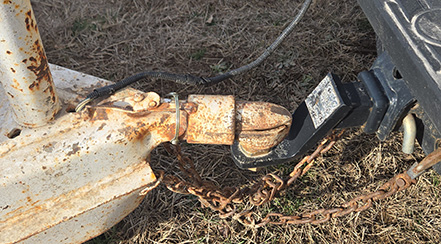
Be sure your hitch is tight and strong. It is wise to use safety chains secured to the frame of the trailer. If the hitch should fail, the chains should maintain control of the trailer until the truck can get stopped.
While fewer people are using straight load two-horse trailers these days, the heavier horse should always be loaded on the left side of a straight load trailer. If hauling a single horse, the horse should be loaded on the left. This is because roads are higher in the center than on the outside, and the driver will have more control of a load with the weight on the left side. Older two-horse trailers tend to be small. Check to make sure horses have plenty of space and headroom. For example, sixteen hand horses need 7-foot-tall trailers.
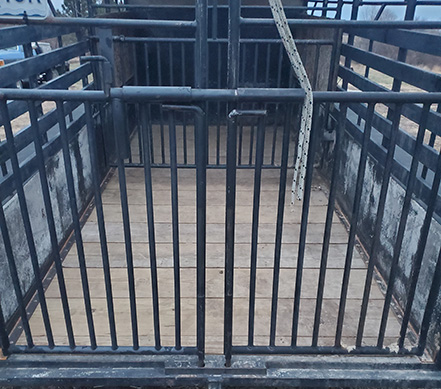
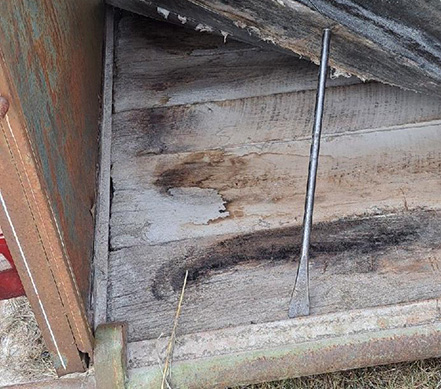
If the weather is cold, blankets may be needed during the trailer ride. On the other hand, if unloading and the horse is wet from perspiration under the blanket, don’t use that blanket under similar conditions next time. It may even be necessary to install plexiglass or wood slats to close openings that the trailer may have in the winter.
During travel, consider tying the horse securely with a slipknot that can be easily released. It may be safe to haul older, experienced horses in trailers without tying their heads. However, in case they lose their footing, these horses can right themselves much easier if their heads are securely tied.

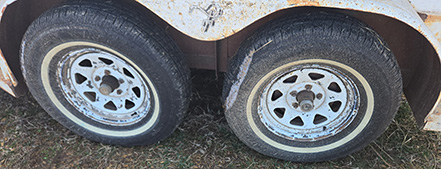
Additionally, be sure all trailer lights are working. Check turn signals, brake lights, running lights, and taillights. The driver should check the condition of the tires, making sure there is no dry rot, cracking, and low air pressure.
Check to make sure that the trailer registration is up to date and the driver has an updated insurance card. A quality spare tire, trailer helper or jack, and lug wrench should be taken on every trip. It is also wise to make sure the trailer wheel bearings are packed, and the floor has been inspected regularly for rot or damage.
The driver should drive slowly the first few miles until they get a feel for the rig they are driving. If a trailer has trailer brakes, it is important to make sure they are working properly. Vehicles towing the trailer should be properly maintained and able to tow and stop the weight of the trailer and horses.
Picking a location to camp
When arriving at camp, pick the camp site carefully. Most campers like to camp near a river for convenience of watering horses. However, nuisance insects may be worse along a stream so plan accordingly.
Consider the tying opportunities for horses and the quietness of the location. The quietest spot may be on the edge of camp, and the noisiest near the center of activities such as a horse show arena or dance floor. Avoid camping near road junctions where there will be more traffic, both mounted and vehicles. Consider the location relative to facilities such as the dining hall, shower houses, etc.
Management on the trail
Get up early enough in the morning to get horses cleaned up, watered and fed at least 90 minutes before riding. Giving ample time between feeding and exercise allows for proper digestion. Riding a full horse reduces the blood flow to the digestive tract, slowing digestion and increasing the likelihood of colic. Full stomachs also reduce capacity for the horse’s lungs, making the exercise more strenuous. Let horses stand and eat hay as they wish. Be sure that all necessary items are packed in saddle bags.
Listen carefully to directions given by the trail boss before making the day’s ride. Although a trail boss will lead the ride, it is safer and more courteous to pay attention to rules and advice given to riders.
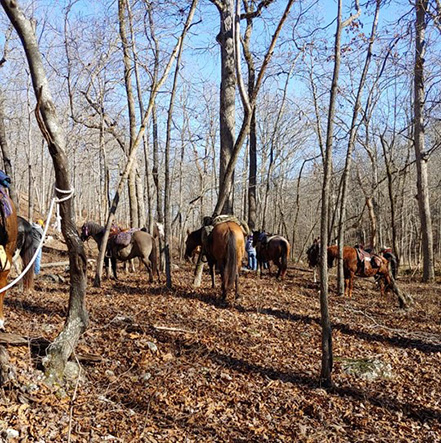
Dismount at refreshment stops. This will allow horses time to relax a bit and relieve their backs from the rider’s weight and reduce the chance of back soreness.
Lunch stops are a great opportunity to rest horses for approximately one hour. Find a cool, shady spot if possible. Loosen the saddle cinch and tie the horse with the neck rope where it cannot twist into tree branches. Most horses are not fed during the lunch hour.
Horses should not be tied with bridle reins. If a horse that is tied in this manner happens to pull back, severe injury can occur to the horse and more than likely the reins or bridle will break.
A hot, thirsty horse will want to drink at the first chance available. Allowing a hot horse to drink an unlimited amount of water can cause colic. For this reason, it is better to allow a horse under these conditions to drink only five or six swallows of water. When the horse has had time to cool off, they can be allowed to drink their fill.
Safety
Experienced trail riders may use colored tail ribbons to indicate potentially dangerous characteristics of the horse that they are riding.
- Red ribbon – may indicate the horse is a kicker
- Yellow or Blue ribbons – may indicate a stallion or an aggressive gelding
- Green ribbon – may be used to let others know that the horse is young and inexperienced
- Pink ribbon – may be used to indicate a moody mare that may kick
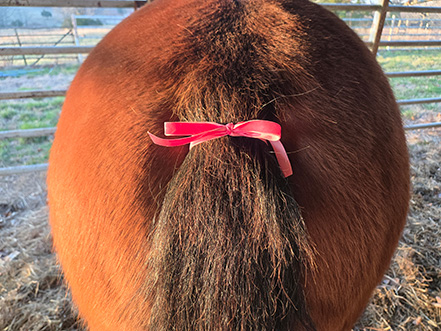
Ride back away from these horses. If crowded, they can severely injure other horses and riders. Be sure to lead horses a sufficient distance away from tied horses that are prone to kick. Sometimes these horses will charge and kick, especially in camp where they are used to eating. While on a ride, if you see any ribbon on a horse’s tail it is best to give that horse and rider extra space.
All riders should practice trail courtesy. While it may be fun to race through streams and splash water on friends, this could cause injury if a young horse should run away or throw its rider.
It is generally accepted that consuming alcohol and operating vehicles or machinery is a poor choice. The same can be said about consuming alcohol and riding horses. Drinking alcoholic beverages is best left to the confines of the camping site.
If a rider or horse becomes injured or lost on the trail, family or friends need to be able to alert the proper authorities. Riders should share the trails they intend to take as well as their estimated departure and return time. Many riders choose to share their GPS location with friends or family members. Some riders use phone apps to share their GPS location through their mobile phone. If the rider is separated from the horse, GPS tracking tags attached to the tack can help locate the horse.
Riders may choose to wear helmets to protect them from brain injuries. Helmets that have been through falls may have damage that is not visible. For this reason, it is best to buy helmets new rather than used and to replace helmets after falls when the helmet has suffered a hard blow. When purchasing helmets, look for helmets that have been inspected by the American Society for Testing and Materials (ASTM) or Safety Equipment Institute (SEI). The label inside the helmet will show the manufacturing date as well as the inspection. It is generally recommended that helmets are replaced every six years. Helmet fit is also important. Make sure that the helmet does not slip around on the rider’s head as this can impair vision while riding and indicates that the helmet is too large, or the straps need to be tightened.

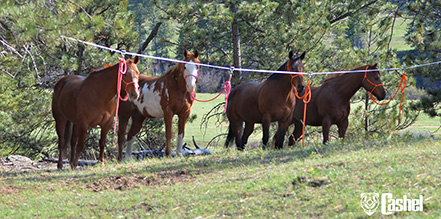
Management in camp
When returning to camp, horses can be tied on a picket line or put in a stall or corral and given a full feeding of hay. Tie horses securely. A good idea is using a neck rope with the shank run through the ring in the halter.
Older, experienced trail horses may be less apt to leave camp if they get loose, while young horses on their first ride may be hopelessly lost if they get loose and try to go home. It may be well to leave saddles on for half an hour to an hour after the ride is over. If a hot horse is uncinched and unsaddled immediately, blood may rush into the veins under the saddle and cause puffs or knots.
Riders should try to adhere to their normal grain feeding schedule while on an overnight trail ride. Hay can be fed free choice while the horse is at camp. Adhering to their normal diet reduces the likelihood of colic. If able, it is best to bring hay and grain the horse is accustomed to.
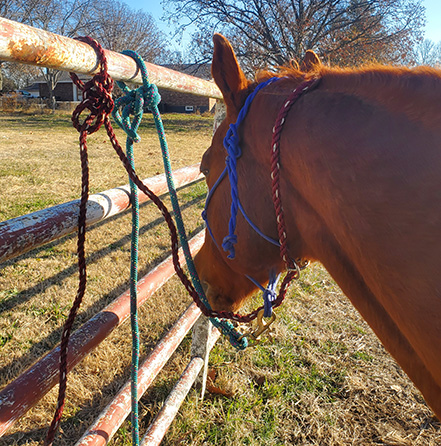
Do not litter on the trails or at the campsite. Always bring trash containers to collect empty bottles, cans, and litter. While riding, trash can be carried in saddlebags or pockets until the next stop or return to camp. Be careful in throwing cigarettes aside in a dry season. As guests of either private landowners or on public property, it is to the benefit of everyone to be considerate and to keep them clean.
Finding trails
Private land can be used with permission from the owner. Some owners may require a liability waiver to be signed beforehand. There are many public lands in Missouri with trails for horses that are controlled by different state or federal agencies.
Missouri State Parks have many trails available for riding. Information about trails allowing horses in Missouri state parks can be found at the Horseback Riding page.
Missouri Department of Conservation also has many trails for riding. A map and information about these trails can be found on the MDC site.
The National Park Service also has resources for finding trails in the Ozark National Scenic Riverways to ride on at the Horseback Riding page.
The United States Department of Agriculture Forest Service has an extensive list of available trails at the horseback riding and camping page.
Resources
To find a complete list of publications, videos, and other resources, visit the Equine Extension program.
- G2835 – Buying a Horse
- G2844 – Haltering and Tying
- G2864 – Pre-Bit Hackamore Training
- G2870 – Tips for Pony Pleasure Drivers
- G2878 – Safe Ground Handling of Horses
- G2881 – Saddling, Bridling and Riding the Western Horse
- G2882 – Safety for Hunt Seat Riders
- G2884 – Community Pleasure Trail Riding
- G2885 – Trail Riding Checklist
- G2887 – Selecting a Saddle